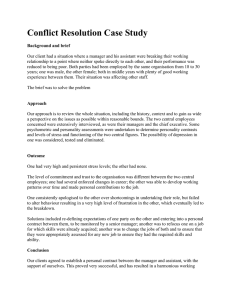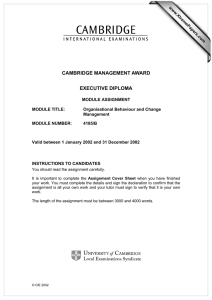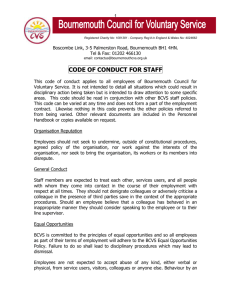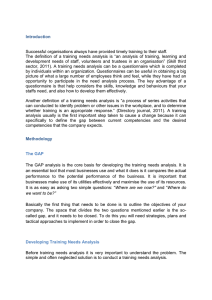15-leadership
advertisement
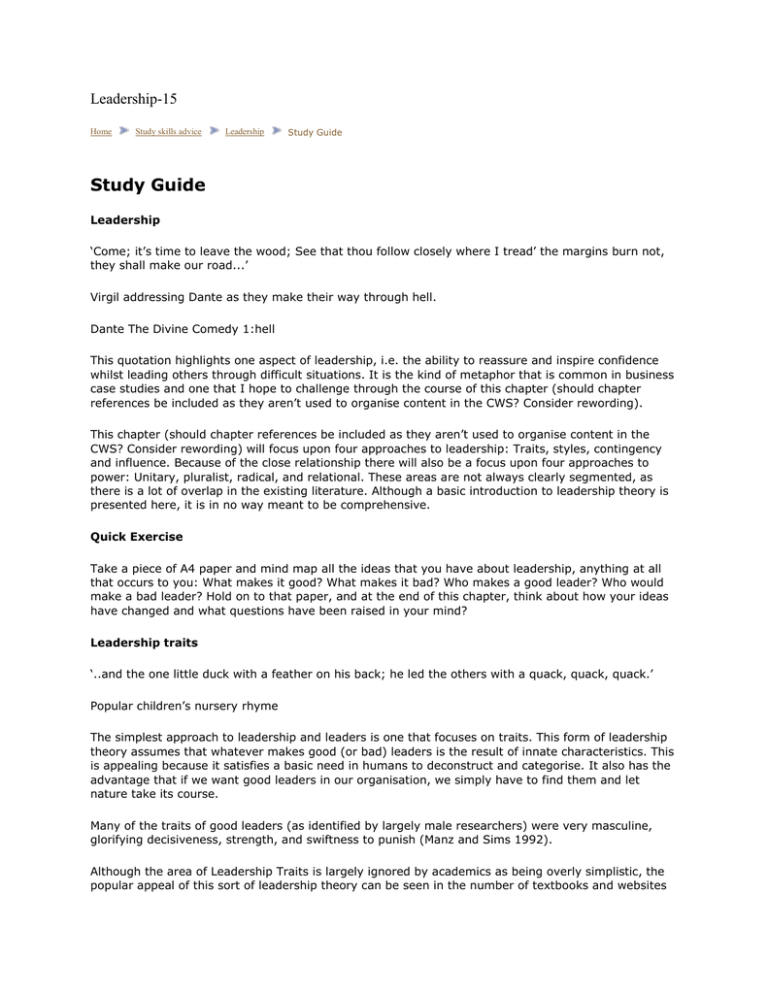
Leadership-15 Home Study skills advice Leadership Study Guide Study Guide Leadership ‘Come; it’s time to leave the wood; See that thou follow closely where I tread’ the margins burn not, they shall make our road...’ Virgil addressing Dante as they make their way through hell. Dante The Divine Comedy 1:hell This quotation highlights one aspect of leadership, i.e. the ability to reassure and inspire confidence whilst leading others through difficult situations. It is the kind of metaphor that is common in business case studies and one that I hope to challenge through the course of this chapter (should chapter references be included as they aren’t used to organise content in the CWS? Consider rewording). This chapter (should chapter references be included as they aren’t used to organise content in the CWS? Consider rewording) will focus upon four approaches to leadership: Traits, styles, contingency and influence. Because of the close relationship there will also be a focus upon four approaches to power: Unitary, pluralist, radical, and relational. These areas are not always clearly segmented, as there is a lot of overlap in the existing literature. Although a basic introduction to leadership theory is presented here, it is in no way meant to be comprehensive. Quick Exercise Take a piece of A4 paper and mind map all the ideas that you have about leadership, anything at all that occurs to you: What makes it good? What makes it bad? Who makes a good leader? Who would make a bad leader? Hold on to that paper, and at the end of this chapter, think about how your ideas have changed and what questions have been raised in your mind? Leadership traits ‘..and the one little duck with a feather on his back; he led the others with a quack, quack, quack.’ Popular children’s nursery rhyme The simplest approach to leadership and leaders is one that focuses on traits. This form of leadership theory assumes that whatever makes good (or bad) leaders is the result of innate characteristics. This is appealing because it satisfies a basic need in humans to deconstruct and categorise. It also has the advantage that if we want good leaders in our organisation, we simply have to find them and let nature take its course. Many of the traits of good leaders (as identified by largely male researchers) were very masculine, glorifying decisiveness, strength, and swiftness to punish (Manz and Sims 1992). Although the area of Leadership Traits is largely ignored by academics as being overly simplistic, the popular appeal of this sort of leadership theory can be seen in the number of textbooks and websites promising to identify the characteristics of great leaders. For a brief illustration see the Changingminds.org website: http://changingminds.org/disciplines/leadership/theories/trait_theory.htm Or the leadership-tools.com website that offers to show you how to become a leader: http://www.leadership-tools.com/free-online-leadership-training.html Leadership styles “When his task is accomplished, his work done, Throughout the country every one says ‘It Happened of its own accord’.” Lao Tzu Tao Te Ching The elusiveness of leadership traits led to a focus on behaviour. Instead of focusing on what makes great business leaders, the focus shifted to what they can do. The theories of leadership styles began with Douglas McGregor (1960) outlining his Theory X and Theory Y model. Assumptions of Theory X focused on the negative aspects of employee behaviour; for example, dislike of work, needing coercion to work hard, and wanting to avoid responsibility. Theory Y takes a more positive view of employee behaviour where work is seen as normal, people do seek responsibility under the right circumstances, and most people are under-utilised at work. For an illustration of his theory, click on the following link: http://www.businessballs.com/mcgregorxytheorydiagram.pdf. McGregor believed that his Theory Y was the best approach to managing people and that most managers were largely reflecting Theory X. McGregor was adamant that lazy, uncooperative employees were always the fault of the management. Blake and Mouton (1978) and Blake and McCanse (1991) identified a more complex variety of styles. Presented on a grid, they clearly identified Team Management as the one best style of managing. It can be useful to think about what kind of style you operate out of, so that you can explore the alternatives. Follow the link for further information about this approach. http://www.maxwideman.com/papers/personality/review1950.htm A criticism that can be made of both Theory X/Y and the leadership grid is that suggesting one style of leadership to suit all circumstances seems overly neat. Furthermore, although the focus has shifted slightly, there is always an underlying assumption that behaviour/style is a result of some inherent traits, leading us back to the problems identified in the previous section. It is worth noting that regardless of its weaknesses, most leadership training in organisations focuses very firmly on style within a contingency/situational framework. Quick Exercise Theory X and Theory Y Use the rating scale below to rate the degree to which you agree or disagree with the following statements. Contingency/contextual approaches to leadership ‘When you forget to take the sail at all, then the wind is consistently in your favour both ways.’ Jerome K Jerome Three men in a boat: to say nothing of the dog! P.118 Wordsworth Classics (1993) A significant development in leadership theory came in 1967 when Fred Fiedler identified leaders as being either relationship-centred or task-centred. Although a number of contingency theories have grown out of this, they are all based on the assumption that, for a given situation, there will be one identifiably best leadership style. Hersey and Blanchard’s (1996) model of situational leadership is also of significance as they move very clearly away from the “attitudes” of leaders and look very much at the range of options managers have for changing their behaviour. They focus particularly on directive and supportive behaviour. The grid they develop implies four key approaches to dealing with people depending on whether you are high/low supportive and high/low directive. They conclude that skilled leadership stems from knowing which of these four areas are needed in a given situation. One of the strongest criticisms of a contingency approach to leadership is that there is a danger of being paralysed by the overwhelming number of possibilities. Hersey and Blanchard’s Leadership Styles Grid The grid is two-dimensional. The horizontal axis represents task behaviour and moves from a low to a high level of maturity. The vertical axis represents relationship behaviour and moves from a low to a high level of relationship. The four possible types of leadership represented by this model are delegating, participating, selling, and telling. Delegating: Leader allows followers to decide/implement (Low relationship/Low task). Participating: Leader involves followers in the decision-making process. (High relationship/Low task). Selling: Leader decides on course of action and sells it (High task/High relationship). Telling: Leader decides on course of action and announces it (High task/Low relationship). Quick Exercise Applying Situational Leadership Identify four situations, either real or hypothetical, that you could be faced with in your current or future job, in which each of the four behaviour styles would be most appropriate: 1. High task, low relationship or Telling 2. High task, high relationship or Selling 3. High relationship, low task or Participating 4. Low task, low relationship or Delegating You may have a preferred style of leadership. This exercise should enable you to think about alternative ways of tackling problems. Leadership as influence During the 1980s, the language of leadership started to change and business theorists began to focus on transformational leadership or managing change as opposed to transactional leadership focused on directing and coordinating efforts to an end goal. It was recognised that leadership was a complex topic that demanded more than a few sound bites and two by two matrices, by way of explanation. From the 1990s, this was taken even further with the development of theories of post-heroic leadership. This theory views the manager as a developer. A post-heroic leader approaches every situation with a view to taking themselves, others, or the organisation forward in some way. Transformational theorists such as Rosabeth Moss Kanter (1983) or Smircich and Morgan (1982) make a clear distinction between managers and leaders. They also focus very much on the ability of leaders to “get things done”. Transformational leaders develop a network of connections throughout the organisation. They also have the ability to structure activities and interpret what is happening in the organisation. At their best, a transformational leader is capable of developing a vision, or direction for the organisation, and securing commitment to move towards this. Criticisms of transformational leadership talks about the superficiality of the visionary leader and also the problem of narcissism when visionary leaders seek to carve out a world that reflects their own image rather than considering what direction is needed in more general terms. Quick Exercise What kind of a leader are you? How would you describe yourself using the models and theories you have been introduced to in this chapter? Try and use concrete examples wherever possible. Return to the mind map that you created at the beginning of this chapter. How have your ideas changed and what questions have been raised in your mind? Quick Test 1 A quick matching test: a ) A feature of trait theories Please select one of the follow ing b ) A feature of leadership style theories Please select one of the follow ing c) A feature of contingenc y approache s d ) Power A feature of leadership as influence Please select one of the follow ing Please select one of the follow ing ‘So he moved on and I moved on behind’ Dante The Divine Comedy 1:hell A definition or theory of power should go some way to answer the question of why people follow a leader. It is a complex area that has been broken down here into four sections. After you have worked through them, we will return to the subjects of leadership, power, and managing change in a more unified manner and attempt to address several related questions. Unitary power This broad theory of power can be characterised as individualistic, mechanised, and bureaucratic. Management authority is presumed to be automatic. The organisation is readily described in terms of hierarchies and organisational charts. Although this sounds simplistic, this is often the view that is presented of organisations in textbooks. The rational model of decision making sits alongside it very well. In a bureaucratic/rational system, power is often not acknowledged. Because power is often linked to conflict and power struggles, it is perceived as an interruption to the rational process and something to be avoided. Example of Unitary Power Pluralist power Another individualistic view of power is the assumption that power is widely dispersed and not concentrated in the hands of an elite group because there are diverse spheres of influence that are accessible to all who wish to participate (Burrell and Morgan 1979). This model is often used to describe political decision making and it is here that one of the main criticisms emerges. In pluralism, there is no acknowledgment that power disparities exist between different groupings and that resources are not freely available to all who wish to participate in the game. Critics have even gone as far as describing pluralism as an ideological tool used to condition some social groups into accepting the status quo. http://www.pfdf.org/leaderbooks/l2l/fall99/new-pluralism.html Leading business theorist Rosabeth Moss Kanter developed a model of the political organisation focusing on empowerment. She argues for the institutionalisation of power so that politics becomes a normal part of the decision-making process and not an aberration. It is the senior management’s responsibility to empower managers by providing resources and support so that the organisation can function more efficiently. Unlike unitarists, pluralists accept that power and politics are part of organisational life, but empowerment is presented as a tool to mitigate this as much as possible. Power and politics are still viewed as selfish, illegitimate activities that work against the interests of the organisation. Radical approaches to power The radical approach to power tries to address some of the most naïve assumptions of pluralism. For instance, Clegg (1989) looks at organisations as systems of domination. Domination, in this instance, is a way of describing the basis of legitimate authority. In any system of domination there are rules, regulations, and systems that are accepted without question. Recruitment procedures, rules for promotion, etc., can be a means to reinforce existing systems of domination. They are part of “the way that we do things around here”. Similarly, Steven Lukes (1974) describes “invisible power” that is used to manipulate knowledge bases in an organisation so that the dominated are not fully aware of issues that may be of interest to them. An illustration of these ideas can be found in job descriptions. The descriptions are often cited as good examples of male domination. It is widely recognised that some occupations have remained largely male because descriptions have been framed using masculine standards. They simultaneously exclude and devalue the contribution of women. Relational approaches to power Relational approaches to power have a very different philosophy to those already covered. A relational approach to power starts with the relationship between the people or actors concerned and not with any intrinsic qualities. Who has the “power to” construct prevailing knowledge or discourses is considered to be of more importance than issues of who or why people have “power over”. Resistance and power complement each other, and although power is not dispersed evenly, there are always possibilities for power relationships to change. Relational theories suggest that traditional constructions of leaders as “powerful and knowledgeable” encourage others to negate, rather than support, their activities. The most productive forms of leadership involve a constant negotiation and re-negotiation of what is important. Your context, your discourses, what you value and what you do not will affect your ability to be the kind of leader you want to be. Leading a dance troupe This example was presented by a final year undergraduate to explain leadership from a relational perspective. As the leader of a dancing “troupe” (a team of 8 or more dancers in a competition), I could discuss and listen to the narrations of all members of the group about previous “troupe” leaders to understand what activities it would make sense for me to undertake, and what activities they would supplement. I could also listen to other narrations of social life or problems at home that might indicate activities that would make more sense for the leader to undertake, given that some people had time constraints and could not, for example, collect the necessary items for their dancing costumes. I could then propose a solution and invite other suggestions to reach a decision through a process of negotiation. Discourses on leadership ‘A discourse is used primarily here to describe a systematic, coherent set of images, metaphors, and so on that construct an object in a particular way’ (Burr 2003). Discourses regulate our knowledge of the world. They also have implications for what we can and cannot do. For instance, prevailing discourses on femininity often construct women as emotional, nurturing, empathic, vulnerable, and susceptible to hormonal changes. From this discourse, it is only a short step to saying that women should care for children and should not have responsible jobs or hold positions in senior management. Discourses are not simply abstract ideas. For instance, if you live within a capitalist society, then almost every aspect of your social life will be supporting this discourse and you will have little opportunity to live your life in a way that complies with a communist rhetoric. As previously discussed, relational views of power focus upon the construction of prevailing knowledge. ‘The critical analysis of discourse, and the production of knowledge (also) lead to more open and democratic organisations, but also emphasise how learning needs to occur in an awareness of the relationship between knowledge and power’. Fulop and Linstead (1999:154) Being aware of the taken-for-granteds in an organisation and challenging them should lead to a more democratic organisation that a greater diversity of people feel comfortable within. Summary Conventional theories suggest that leaders’ activities should be driven by the values of the group, since values shape behaviour. The group’s ideas and values may be discussed but ultimately the leader makes the final judgement call in a subject/object manner. In direct contrast to this, the relational approach to leadership locates behaviour between individuals. The identity and activities of leadership are located in the complex web of relationships with others. To frame it simplistically, from this perspective, you cannot be a leader if you are alone, and you cannot possess leadership qualities, as such qualities are based on social interactions with others. Furthermore, from this perspective if a leader decides upon his or her activities without engaging significantly with others, then this denies the others an opportunity to input into their own identity. Whether you accept the traditional models of leadership or more radical models such as the one proposed by relational theorists, developing your reflective skills, learning skills, and communication skills has enormous value. With skills such as these, your sensitivity and awareness of interactions with others is heightened and your potential for making positive contributions to a business organisation is greatly enhanced.
